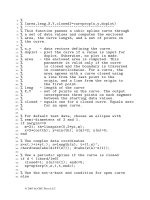Advanced Mathematics and Mechanics Applications Using MATLAB phần 3 pptx
Bạn đang xem bản rút gọn của tài liệu. Xem và tải ngay bản đầy đủ của tài liệu tại đây (6.33 MB, 61 trang )
2: %
3: % [area,leng,X,Y,closed]=curvprop(x,y,doplot)
4: % ~~~~~~~~~~~~~~~~~~~~~~~~~~~~~~~~~~~~~~~~~~
5: % This function passes a cubic spline curve through
6: % a set of data values and computes the enclosed
7: % area, the curve length, and a set of points on
8: % the curve.
9: %
10: % x,y - data vectors defining the curve.
11: % doplot - plot the curve if a value is input for
12: % doplot. Otherwise, no plot is made.
13: % area - the enclosed area is computed. This
14: % parameter is valid only if the curve
15: % is closed and the boundary is traversed
16: % in counterclockwise. For a curve, the
17: % area agrees with a curve closed using
18: % a line from the last point to the
19: % origin, and a line from the origin to
20: % the first point.
21: % leng - length of the curve
22: % X,Y - set of points on the curve. The output
23: % intersperses three points on each segment
24: % between the starting data values.
25: % closed - equals one for a closed curve. Equals zero
26: % for an open curve.
27: %
28:
29:
% For default test data, choose an ellipse with
30: % semi-diameters of 2 and 1.
31: if nargin==0
32: m=21; th=linspace(0,2*pi,m);
33: x=2*cos(th); y=sin(th); x(m)=2; y(m)=0;
34: end
35:
36:
% Use complex data coordinates
37: z=x(:)+i*y(:); n=length(z); t=(1:n)’;
38: chord=sum(abs(diff(z))); d=abs(z(n)-z(1));
39:
40:
% Use a periodic spline if the curve is closed
41: if d < (chord/1e6)
42: closed=1; z(n)=z(1); endc=5;
43: zp=spterp(t,z,1,t,endc);
44:
45:
% Use the not-a-knot end condition for open curve
46: else
© 2003 by CRC Press LLC
47: closed=0; endc=1; zp=spterp(t,z,1,t,endc);
48: end
49:
50:
% Compute length and area
51: % plot(abs(zp)),shg,pause
52: leng=spterp(t,abs(zp),3,n,1);
53: area=spterp(t,1/2*imag(conj(z).*zp),3,n,1);
54: Z=spterp(t,z,0,1:1/4:n,endc);
55: X=real(Z); Y=imag(Z);
56: if nargin>2
57: plot(X,Y,’-’,x,y,’.’), axis equal
58: xlabel(’x axis’), ylabel(’y axis’)
59: title(’SPLINE CURVE’), shg
60: end
61:
62:
%============================================
63:
64:
function [v,c]=spterp(xd,yd,id,x,endv,c)
65: %
66: % [v,c]=spterp(xd,yd,id,x,endv,c)
67: % ~~~~~~~~~~~~~~~~~~~~~~~~~~~~~~
68: %
69: % This function performs cubic spline interpo-
70: % lation. Values of y(x),y’(x),y’’(x) or the
71: % integral(y(t)*dt, xd(1) x) are obtained.
72: % Five types of end conditions are provided.
73: %
74: % xd, yd - data vectors with xd arranged in
75: % ascending order.
76: % id - id equals 0,1,2,3 to compute y(x),
77: % y’(x), integral(y(t)*dt,t=xd(1) x),
78: % respectively.
79: % v - values of the function, first deriva-
80: % tive, second derivative, or integral
81: % from xd(1) to x
82: % c - the coefficients defining the spline
83: % curve. If these values are input from
84: % an earlier computation, then they
85: % are not recomputed.
86: % endv - vector giving the end conditions in
87: % one of the following five forms:
88: % endv=1 or endv omitted makes
89: % c(2) and c(n-1) zero
90: % endv=[2,left_end_slope,
91: % right_end_slope] to impose slope
© 2003 by CRC Press LLC
92: % values at each end
93: % endv=[3,left_end_slope] imposes the
94: % left end slope value and makes
95: % c(n-1) zero
96: % endv=[4,right_end_slope] imposes the
97: % right end slope value and makes
98: % c(2) zero
99: % endv=5 defines a periodic spline by
100: % making y,y’,y" match at both ends
101:
102:
if nargin<5 | isempty(endv), endv=1; end
103: n=length(xd); sx=size(x); x=x(:); X=x-xd(1);
104:
105:
if nargin<6, c=spcof(xd,yd,endv); end
106:
107:
C=c(1:n); s1=c(n+1); m1=c(n+2); X=x-xd(1);
108:
109:
if id==0 % y(x)
110: v=yd(1)+s1*X+m1/2*X.*X+
111: powermat(x,xd,3)*C/6;
112: elseif id==1 % y’(x)
113: v=s1+m1*X+powermat(x,xd,2)*C/2;
114: elseif id==2 % y’’(x)
115: v=m1+powermat(x,xd,1)*C;
116: else % integral(y(t)*dt, t=xd(1) x)
117: v=yd(1)*X+s1/2*X.*X+m1/6*X.^3+
118: powermat(x,xd,4)*C/24;
119: end
120: v=reshape(v,sx);
121:
122:
%==============================================
123:
124:
function c=spcof(x,y,endv)
125: %
126: % c=spcof(x,y,endv)
127: % ~~~~~~~~~~~~~~~~
128: % This function determines spline interpolation
129: % coefficients consisting of the support
130: % reactions concatenated with y’ and y’’ at
131: % the left end.
132: % x,y - data vectors of interplation points.
133: % Denote n as the length of x.
134: % endv - vector of data for end conditions
135: % described in function spterp.
136: %
© 2003 by CRC Press LLC
137: % c - a vector [c(1); ;c(n+2)] where the
138: % first n components are support
139: % reactions and the last two are
140: % values of y’(x(1)) and y’’(x(1)).
141:
142:
if nargin<3, endv=1; end
143: x=x(:); y=y(:); n=length(x); u=x(2:n)-x(1);
144: a=zeros(n+2,n+2); a(1,1:n)=1;
145: a(2:n,:)=[powermat(x(2:n),x,3)/6,u,u.*u/2];
146: b=zeros(n+2,1); b(2:n)=y(2:n)-y(1);
147: if endv(1)==1 % Force, force condition
148: a(n+1,2)=1; a(n+2,n-1)=1;
149: elseif endv(1)==2 % Slope, slope condition
150: b(n+1)=endv(2); a(n+1,n+1)=1;
151: b(n+2)=endv(3); a(n+2,:)=
152: [((x(n)-x’).^2)/2,1,x(n)-x(1)];
153: elseif endv(1)==3 % Slope, force condition
154: b(n+1)=endv(2); a(n+1,n+1)=1; a(n+2,n-1)=1;
155: elseif endv(1)==4 % Force, slope condition
156: a(n+1,2)=1; b(n+2)=endv(2);
157: a(n+2,:)=[((x(n)-x’).^2)/2,1,x(n)-x(1)];
158: elseif endv(1)==5
159: a(n+1,1:n)=x(n)-x’; b(n)=0;
160: a(n+2,1:n)=1/2*(x(n)-x’).^2;
161: a(n+2,n+2)=x(n)-x(1);
162: else
163: error(
164: ’Invalid value of endv in function spcof’)
165: end
166: if endv(1)==1 & n<4, c=pinv(a)*b;
167: else, c=a\b; end
168:
169:
%==============================================
170:
171:
function a=powermat(x,X,p)
172: %
173: % a=powermat(x,X,p)
174: % ~~~~~~~~~~~~~~~~
175: % This function evaluates various powers of a
176: % matrix used in cubic spline interpolation.
177: %
178: % x,X - arbitrary vectors of length n and N
179: % a - an n by M matrix of elements such that
180: % a(i,j)=(x(i)>X(j))*abs(x(i)-X(j))^p
181:
© 2003 by CRC Press LLC
182: x=x(:); n=length(x); X=X(:)’; N=length(X);
183: a=x(:,ones(1,N))-X(ones(n,1),:); a=a.*(a>0);
184: switch p, case 0, a=sign(a); case 1, return;
185: case 2, a=a.*a; case 3; a=a.*a.*a;
186: case 4, a=a.*a; a=a.*a; otherwise, a=a.^p; end
4.2.3 Generalizing the Intrinsic Spline Function in MATLAB
The intrinsic MATLAB function spline employs an auxiliary function unmk to
create the piecewise polynomial deÞnitions deÞning the spline. The polynomials
can be differentiated or integrated, and then functions mkpp and ppval can be used
to evaluate results. We have employed the ideas from those routines to develop func-
tions splineg and splincof extending the minimal spline capabilities of MATLAB.
The function splincof(xd,yd,endc) computes arrays b and c usable by mkpp and pp-
val. The data vector endc deÞnes the Þrst four types of end conditions discussed
above. The function splineg(xd,yd,x,deriv,endc,b,c) handles the same kind of data
as function spterp. Sometimes arrays b and c may have been created from a previ-
ous call to splineg or spterp. Whenever these are passed through the call list, they
are used by splineg without recomputation. Readers wanting more details on spline
concepts should consult de Boor’s book [7].
Two examples illustrating spline interpolation are presented next. In the Þrst pro-
gram called, sinetrp, a series of equally spaced points between 0 and 2π is used to
approximate y =sin(x) which satisÞes
y
(x)=cos(x) ,y
(x)=−sin(x) ,
x
0
y(x)dx =1−cos(x).
The approximations for the function, derivatives, and the integral are evaluated using
splineg. Results shown in Figure 4.1 are quite satisfactory, except for points outside
the data interval [0, 2π].
© 2003 by CRC Press LLC
−0.5 0 0.5 1 1.5 2 2.5
−1.5
−1
−0.5
0
0.5
1
1.5
2
Spline Differentiation and Integration of sin(x)
x / pi
function values
y=sin(x)
data
y’(x)
y’’(x)
∫ y(x) dx
Figure 4.1: Spline Differentiation and Integration of sin(x)
© 2003 by CRC Press LLC
Example: Spline Interpolation Applied to Sin(x)
Program sinetrp
1: function sinetrp
2: % Example: sinetrp
3: % ~~~~~~~~~~~~~~~~~
4: % This example illustrates cubic spline
5: % approximation of sin(x), its first two
6: % derivatives, and its integral.
7: %
8: % User m functions required:
9: % splineg, splincof
10:
11:
% Create data points on the spline curve
12: xd=linspace(0,2*pi,21); yd=sin(xd);
13:
14:
% Evaluate function values at a dense
15: % set of points
16: x=linspace(-pi/2,5/2*pi,61);
17: [y,b,c]=splineg(xd,yd,x,0);
18: yp=splineg(xd,yd,x,1,[],b,c);
19: ypp=splineg(xd,yd,x,2,[],b,c);
20: yint=splineg(xd,yd,x,3,[],b,c);
21:
22:
% Plot results
23: z=x/pi; zd=xd/pi;
24: plot(z,y,’k-’,zd,yd,’ko’,z,yp,’k:’,
25: z,ypp,’k ’,z,yint,’k+’);
26: title([’Spline Differentiation and ’,
27: ’Integration of sin(x)’]);
28: xlabel(’x / pi’); ylabel(’function values’);
29: legend(’y=sin(x)’,’data’,’y’’(x)’,’y’’’’(x)’,
30: ’\int y(x) dx’,1); grid on
31: figure(gcf); pause;
32: % print -deps sinetrp
33:
34:
%==============================================
35:
36:
function [val,b,c]=splineg(xd,yd,x,deriv,endc,b,c)
37: %
38: % [val,b,c]=splineg(xd,yd,x,deriv,endc,b,c)
39: % ~~~~~~~~~~~~~~~~~~~~~~~~~~~~~~~~~~~~~~~~~
40: %
© 2003 by CRC Press LLC
41: % For a cubic spline curve through data points
42: % xd,yd, this function evaluates y(x), y’(x),
43: % y’’(x), or integral(y(x)*dx, xd(1) to x(j) )
44: % for j=1:length(x).The coefficients needed to
45: % evaluate the spline are also computed.
46: %
47: % xd,yd - data vectors defining the cubic
48: % spline curve
49: % x - vector of points where curve
50: % properties are computed.
51: % deriv - denoting the spline curve as y(x),
52: % deriv=0 gives a vector for y(x)
53: % deriv=1 gives a vector for y’(x)
54: % deriv=2 gives a vector for y’’(x)
55: % deriv=3 gives a vector of values
56: % for integral(y(z)*dz) from xd(1)
57: % to x(j) for j=1:length(x)
58: % endc - endc=1 makes y’’’(x) continuous at
59: % xd(2) and xd(end-1).
60: % endc=[2,left_slope,right_slope]
61: % imposes slope values at both ends.
62: % endc=[3,left_slope] imposes the left
63: % end slope and makes the discontinuity
64: % of y’’’ at xd(end-1) small.
65: % endc=[4,right_slope] imposes the right
66: % end slope and makes the discontinuity
67: % of y’’’ at xd(2) small.
68: % b,c coefficients needed to perform the
69: % spline interpolation. If these are not
70: % given, function unmkpp is called to
71: % generate them.
72: % val values y(x),y’(x),y’’(x) or
73: % integral(y(z)dz, z=xd(1) x) for
74: % deriv=0,1,2, or 3, respectively.
75:
76:
if nargin<5 | isempty(endc), endc=1; end
77: if nargin<7, [b,c]=splincof(xd,yd,endc); end
78: n=length(xd); [N,M]=size(c);
79:
80:
switch deriv
81:
82:
case 0 % Function value
83: val=ppval(mkpp(b,c),x);
84:
85:
case 1 % First derivative
© 2003 by CRC Press LLC
86: C=[3*c(:,1),2*c(:,2),c(:,3)];
87: val=ppval(mkpp(b,C),x);
88:
89:
case 2 % Second derivative
90: C=[6*c(:,1),2*c(:,2)];
91: val=ppval(mkpp(b,C),x);
92:
93:
case 3 % Integral values from xd(1) to x
94: k=M:-1:1;
95: C=[c./k(ones(N,1),:),zeros(N,1)];
96: dx=xd(2:n)-xd(1:n-1); s=zeros(n-2,1);
97: for j=1:n-2, s(j)=polyval(C(j,:),dx(j)); end
98: C(:,5)=[0;cumsum(s)]; val=ppval(mkpp(b,C),x);
99:
100:
end
101:
102:
%==============================================
103:
104:
function [b,c]=splincof(xd,yd,endc)
105: %
106: % [b,c]=splincof(xd,yd,endc)
107: % ~~~~~~~~~~~~~~~~~~~~~~~~~~
108: % This function determines coefficients for
109: % cubic spline interpolation allowing four
110: % different types of end conditions.
111: % xd,yd - data vectors for the interpolation
112: % endc - endc=1 makes y’’’(x) continuous at
113: % xd(2) and xd(end-1).
114: % endc=[2,left_slope,right_slope]
115: % imposes slope values at both ends.
116: % endc=[3,left_slope] imposes the left
117: % end slope and makes the discontinuity
118: % of y’’’ at xd(end-1) small.
119: % endc=[4,right_slope] imposes the right
120: % end slope and makes the discontinuity
121: % of y’’’ at xd(2) small.
122: %
123: if nargin<3, endc=1; end;
124: type=endc(1); xd=xd(:); yd=yd(:);
125:
126:
switch type
127:
128:
case 1
129: % y’’’(x) continuous at the xd(2) and xd(end-1)
130: [b,c]=unmkpp(spline(xd,yd));
© 2003 by CRC Press LLC
131:
132:
case 2
133: % Slope given at both ends
134: [b,c]=unmkpp(spline(xd,[endc(2);yd;endc(3)]));
135:
136:
case 3
137: % Slope at left end given. Compute right end
138: % slope.
139: [b,c]=unmkpp(spline(xd,yd));
140: c=[3*c(:,1),2*c(:,2),c(:,3)];
141: sright=ppval(mkpp(b,c),xd(end));
142: [b,c]=unmkpp(spline(xd,[endc(2);yd;sright]));
143:
144:
case 4
145: % Slope at right end known. Compute left end
146: % slope.
147: [b,c]=unmkpp(spline(xd,yd));
148: c=[3*c(:,1),2*c(:,2),c(:,3)];
149: sleft=ppval(mkpp(b,c),xd(1));
150: [b,c]=unmkpp(spline(xd,[sleft;yd;endc(2)]));
151:
152:
end
4.2.4 Example: A Spline Curve with Several Parts and Corners
The Þnal spline example illustrates interpolation of a two-dimensional curve where
y cannot be expressed as a single valued function of x. Then we introduce a param-
eter t
j
having its value equal to the index for each (x
j
,y
j
) used. Interpolating
x(t) and y(t) as continuous functions of t produces a smooth curve through the data.
Function matlbdat creates data points to deÞne the curve and calls function spcry2d
to compute points on a general plane curve. We also introduce the idea of ‘corner
points’ where slope discontinuity allows the curve to make sharp turns needed to
describe letters such as the ‘t’ in MATLAB. Each curve segment between successive
pairs of corner points is parameterized using function spline. Results in Figure 4.2
show clearly that spline interpolation can represent a complicated curve. The re-
lated code appears after the Þgure. The same kind of parameterization used for two
dimensions also works well for three dimensional curves.
Example: Spline Curve Drawing the Word MATLAB
Program matlbdat
1: function matlbdat
© 2003 by CRC Press LLC
A Spline Curve Drawing the Word MATLAB
Figure 4.2: Spline Curve Drawing the Word MATLAB
© 2003 by CRC Press LLC
2: % Example: matlbdat
3: % ~~~~~~~~~~~~~~~~~
4: % This example illustrates the use of splines
5: % to draw the word MATLAB.
6: %
7: % User m functions required: spcurv2d
8:
9:
x=[13 17 17 16 17 19 21 22 21 21 23 26
10: 25 28 30 32 37 32 30 32 35 37 37 38
11: 41 42 42 42 45 39 42 42 44 47 48 48
12: 47 47 48 51 53 57 53 52 53 56 57 57
13: 58 61 63 62 61 64 66 64 61 64 67 67];
14: y=[63 64 58 52 57 62 62 58 51 58 63 63
15: 53 52 56 61 61 61 56 51 55 61 55 52
16: 54 59 63 59 59 59 59 54 52 54 58 62
17: 58 53 51 55 60 61 60 54 51 55 61 55
18: 52 53 58 62 53 57 53 51 53 51 51 51];
19: x=x’; x=x(:); y=y’; y=y(:);
20: ncrnr=[17 22 26 27 28 29 30 31 36 42 47 52];
21: clf; [xs,ys]=curv2d(x,y,10,ncrnr);
22: plot(xs,ys,’k-’,x,y,’k*’), axis off;
23: title(’A Spline Curve Drawing the Word MATLAB’);
24: figure(gcf);
25: % print -deps matlbdat
26:
27:
%=============================================
28:
29:
function [X,Y]=spcrv2d(xd,yd,nseg,icrnr)
30: %
31: % [X,Y]=spcrv2d(xd,yd,nseg,icrnr)
32: % ~~~~~~~~~~~~~~~~~~~~~~~~~~~~
33: % This function computes points (X,Y) on a
34: % spline curve through (xd,yd) allowing slope
35: % discontinuities at points with corner
36: % indices in icrnr. nseg plot segments are
37: % used between each successive pair of points.
38:
39:
if nargin<4, icrnr=[]; end
40: if nargin<3, nseg=10; end
41: zd=xd(:)+i*yd(:); n=length(zd);
42: N=[1;sort(icrnr(:));n]; Z=zd(1);
43: if N(1)==N(2); N(1)=[]; end
44: if N(end)==N(end-1); N(end)=[]; end
45: for k=1:length(N)-1
46: zk=zd(N(k):N(k+1)); sk=length(zk)-1;
© 2003 by CRC Press LLC
47: s=linspace(0,sk,1+sk*nseg)’;
48: Zk=spline(0:sk,zk,s); Z=[Z;Zk(2:end)];
49: end
50: X=real(Z); Y=imag(Z);
4.3 Numerical Differentiation Using Finite Differences
Differential equation problems are sometimes solved using difference formulas to
approximate the derivatives in terms of function values at adjacent points. Deriving
difference formulas by hand can be tedious, particularly when unequal point spacing
is used. For this reason, we develop a numerical procedure to construct formulas
of arbitrary order and arbitrary truncation error. Of course, as the desired order
of derivative and the order of truncation error increases, more points are needed to
interpolate the derivative. We will show below that approximating a derivative of
order k with a truncation error of order h
m
generally requires (k + m) points unless
symmetric central differences are used. Consider the Taylor series expansion
F (x + αh)=
∞
k=0
F
(k)
(x)
k!
(αh)
k
where F
(k)
(x) means the k’th derivative of F (x). This relation expresses values of
F as linear combinations of the function derivatives at x. Conversely, the derivative
values can be cast in terms of function values by solving a system of simultaneous
equations. Let us take a series of points deÞned by
x
ı
= x + hα
ı
, 1 ≤ ı ≤ n
where h is a Þxed step-size and α
ı
are arbitrary parameters. Separating some leading
terms in the series expansion gives
F (x
ı
)=
n−1
k=0
α
k
ı
k!
h
k
F
(k)
(x)
+
α
n
ı
n!
h
n
F
(n)
(x)
+
α
n+1
ı
(n +1)!
h
(n+1)
F
(n+1)
(x)
+ O(h
n+2
) , 1 ≤ ı ≤ n.
It is helpful to use the following notation:
α
k
– a column vector with component ı being equal to α
k
ı
f – a column vector with component ı being F (x
ı
)
fp – a column vector with component ı being h
ı
F
(ı)
(x)
A – [α
0
,α
1
, ,α
n−1
], a square matrix with columns which
are powers of α.
© 2003 by CRC Press LLC
Then the Taylor series expressed in matrix form is
f = A ∗ fp+
h
n
F
(n)
(x)
n!
α
n
+
h
n+1
F
(n+1)
(x)
(n +1)!
α
n+1
+ O(h
n+2
).
Solving this system for the derivative matrix fpyields
fp = A
−1
f −
h
n
F
(n)
(x)
n!
A
−1
α
n
−
h
n+1
F
(n+1)
(x)
(n +1)!
A
−1
α
n+1
+ O(h
n+2
).
In the last equation we have retained the Þrst two remainder terms in explicit form
to allow the magnitudes of these terms to be examined. Row k +1of the previous
equation implies
F
(k)
(x)=h
−k
(A
−1
f)
k+1
−
h
n−k
n!
F
(n)
(x)(A
−1
α
n
)
k+1
−
h
n−k+1
(n +1)!
F
(n+1)
(x)(A
−1
α
n+1
)
k+1
+ O(h
n−k+1
) .
Consequently, the rows of A
−1
provide coefÞcients in formulas to interpolate deriva-
tives. For a particular number of interpolation points, say N, the highest derivative
approximated will be F
(N−1)
(x) and the truncation error will normally be of or-
der h
1
. Conversely, if we need to compute a derivative formula of order k with the
truncation error being m, then it is necessary to use a number of points such that
n −k = m; therefore n = m + k. For the case where interpolation points are sym-
metrically placed around the point where derivatives are desired, one higher power
of accuracy order is achieved than might be expected. We can show, for example,
that
d
4
F (x)
dx
4
=
1
h
4
(F (x − 2h) − 4F(x −h)+6F (x) −
4F (x + h)+F (x +2h)) + O(h
2
)
because the truncation error term associated with h
1
is found to be zero. At the
same time, we can show that a forward difference formula for f
(x) employing
equidistant point spacing is
d
3
F (x)
dx
3
=
1
h
3
(−2.5F (x) − 9F(x + h)+12F (x +2h)+
7F (x +3h) − 1.5F (x +4h)) + O(h
2
).
Although the last two formulas contain arithmetically simple interpolation coefÞ-
cients, due to equal point spacing, the method is certainly not restricted to equal
spacing. The following program contains the function derivtrp which implements
the ideas just developed. Since the program contains documentation that is output
when it is executed, no additional example problem is included.
© 2003 by CRC Press LLC
4.3.1 Example: Program to Derive Difference Formulas
Output from Example
finitdif;
COMPUTING F(x,k), THE K’TH DERIVATIVE OF
f(x), BY FINITE DIFFERENCE APPROXIMATION
Input the derivative order (give 0 to stop,
or ? for an explanation) > ?
Let f(x) have its k’th derivative denoted by
F(k,x). The finite difference formula for a
stepsize h is given by:
F(x,k)=Sum(c(j)*f(x+a(j)*h), j=1:n)/hˆk +
TruncationError
with m=n-k being the order of truncation
error which decreases like hˆm according to:
TruncationError=-(hˆm)*(e(1)*F(x,n)+
e(2)*F(x,n+1)*h+e(3)*F(x,n+2)*hˆ2+O(hˆ3))
Input the derivative order (give 0 to stop,
or ? for an explanation) > 4
Give the required truncation order > 1
To define interpolation points X(j)=x+h*a(j),
input at least 5 components for vector a.
Components of a > -2,-1,0,1,2
The formula for a derivative of order 4 is:
F(x,k)=sum(c(j)*F(X(j),j=1:n)/hˆ4+order(hˆ1)
where c is given by:
1.0000 -4.0000 6.0000 -4.0000 1.0000
and the truncation error coefficients are:
-0.0000 0.1667 -0.0000 0.0125
Input the derivative order (give 0 to stop,
© 2003 by CRC Press LLC
or ? for an explanation) > 3
Give the required truncation order > 2
To define interpolation points X(j)=x+h*a(j),
input at least 5 components for vector a.
Components of a > 0,1,2,3,4
The formula for a derivative of order 3 is:
F(x,k)=sum(c(j)*F(X(j),j=1:n)/hˆ3+order(hˆ2)
where c is given by:
-2.5000 9.0000 -12.0000 7.0000 -1.5000
and the truncation error coefficients are:
-1.7500 -2.5000 -2.1417 -1.3750
Input the derivative order (give 0 to stop,
or ? for an explanation) > 0
Program Þnitdif
1: function [c,e,m,crat,k,a]=finitdif(k,a)
2: %
3: % [c,e,m,crat,k,a]=finitdif(k,a)
4: % ~~~~~~~~~~~~~~~~~~~~~~~~~~~~~
5: % This program computes finite difference formulas of
6: % general order. For explanation of the input and
7: % output parameters, see the following function
8: % findifco. When the program is executed without input
9: % arguments, then input is read interactively.
10:
11:
if nargin==0, disp(’ ’) % Use interactive input
12: disp(’COMPUTING F(x,k), THE K’’TH DERIVATIVE OF’)
13: disp(’f(x), BY FINITE DIFFERENCE APPROXIMATION’)
14: disp(’ ’)
15: while 1
16: disp(’Input the derivative order (give 0 to stop,’)
17: K=input(’or ? for an explanation) > ’,’s’);
18: k=str2num(K);
19: if strcmp(K,’’) | strcmp(K,’0’); disp(’ ’),return
© 2003 by CRC Press LLC
20: elseif strcmp(K,’?’)
21: disp(’ ’), disp(
22: ’Let f(x) have its k’’th derivative denoted by’)
23: disp(
24: ’F(k,x). The finite difference formula for a’)
25: disp(’stepsize h is given by:’), disp(’ ’)
26: disp(
27: ’F(x,k)=Sum(c(j)*f(x+a(j)*h), j=1:n)/h^k + ’)
28: disp(’ TruncationError’), disp(’ ’)
29: disp(’with m=n-k being the order of truncation’)
30: disp(
31: ’error which decreases like h^m according to:’)
32: disp(’ ’)
33: disp(’TruncationError=-(h^m)*(e(1)*F(x,n)+ ’)
34: disp(
35: ’e(2)*F(x,n+1)*h+e(3)*F(x,n+2)*h^2+O(h^3))’)
36: disp(’ ’)
37: else
38: disp(’ ’)
39: m=input(’Give the required truncation order > ’);
40: n=m+k; N=num2str(n); disp(’ ’), disp(
41: ’To define interpolation points X(j)=x+h*a(j),’)
42: disp([’input at least ’,N,
43: ’ components for vector a.’])
44: disp(’ ’), aa=input(’Components of a > ’,’s’);
45: a=eval([’[’,aa,’]’]); n=length(a); m=n-k;
46: [c,e,m,crat]=findifco(k,a); disp(’ ’), disp(
47: [’The formula for a derivative of order ’,
48: K,’ is:’])
49: disp([’F(x,k)=sum(c(j)*F(X(j),j=1:n)/h^’,K,
50: ’+order(h^’,num2str(m),’)’])
51: disp(’where c is given by:’)
52: disp(’ ’), disp(c), disp(’ ’)
53: disp(
54: ’and the truncation error coefficients are:’)
55: disp(’ ’), disp(e)
56: end
57: end
58: else
59: [c,e,m,crat]=findifco(k,a);
60: end
61:
62:
%==================================================
63:
64:
function [c,e,m,crat]=findifco(k,a)
© 2003 by CRC Press LLC
65: %
66: % [c,e,m,crat]=findifco(k,a)
67: % ~~~~~~~~~~~~~~~~~~~~~~~~~
68: % This function approximates the k’th derivative
69: % of a function using function values at n
70: % interpolation points. Let f(x) be a general
71: % function having its k’th derivative denoted
72: % by F(x,k). The finite difference approximation
73: % for the k’th derivative employing a stepsize h
74: % is given by:
75: % F(x,k)=Sum(c(j)*f(x+a(j)*h), j=1:n)/h^k +
76: % TruncationError
77: % with m=n-k being the order of truncation
78: % error which decreases like h^m and
79: % TruncationError=(h^m)*(e(1)*F(x,n)+
80: % e(2)*F(x,n+1)*h+e(3)*F(x,n+2)*h^2+O(h^3))
81: %
82: % a - a vector of length n defining the
83: % interpolation points x+a(j)*h where
84: % x is an arbitrary parameter point
85: % k - order of derivative evaluated at x
86: % c - the weighting coeffients in the
87: % difference formula above. c(j) is
88: % the multiplier for value f(x+a(j)*h)
89: % e - error component vector in the above
90: % difference formula
91: % m - order of truncation order in the
92: % formula. The relation m=n-k applies.
93: % crat - a matrix of integers such that c is
94: % approximated by crat(1,:)./crat(2,:)
95:
96:
a=a(:); n=length(a); m=n-k; mat=ones(n,n+4);
97: for j=2:n+4; mat(:,j)=a/(j-1).*mat(:,j-1); end
98: A=pinv(mat(:,1:n)); ec=-A*mat(:,n+1:n+4);
99: c=A(k+1,:); e=-ec(k+1,:);
100: [ctop,cbot]=rat(c,1e-8); crat=[ctop(:)’;cbot(:)’];
© 2003 by CRC Press LLC
Chapter 5
Gauss Integration with Geometric Property
Applications
5.1 Fundamental Concepts and Intrinsic Integration Tools
in MATLAB
Numerical integration methods approximate a deÞnite integral by evaluating the
integrand at several points and taking a weighted combination of those integrand
values. The weight factors can be obtained by interpolating the integrand at selected
points and integrating the interpolating function exactly. For example, the Newton-
Cotes formulas result from polynomial interpolation through equidistant base points.
This chapter discusses concepts of numerical integration needed in applications.
Let us assume that an integral over limits a to b is to be evaluated. We can write
b
a
f(x)dx =
n
ı=1
W
ı
f(x
ı
)+E
where E represents the error due to replacement of the integral by a Þnite sum. This
is called an n-point quadrature formula. The points x
ı
where the integrand is evalu-
ated are the base points and the constants W
ı
are the weight factors. Most integration
formulas depend on approximating the integrand by a polynomial. Consequently,
they give exact results when the integrand is a polynomial of sufÞciently low order.
Different choices of x
ı
and W
ı
will be discussed below.
It is helpful to express an integral over general limits in terms of some Þxed limits,
say −1 to 1. This is accomplished by introducing a linear change of variables
x = α + βt.
Requiring that x = a corresponds to t = −1 and that x = b corresponds to t =1
gives α =(a + b)/2 and β =(b − a)/2, so that one obtains
b
a
f(x)dx =
1
2
(b −a)
1
−1
f
a + b
2
+
b − a
2
t
dt =
1
−1
F (t)dt
where F (t)=f[(a + b)/2+(b − a)t/2](b − a)/2. Thus, the dependence of the
integral on the integration limits can be represented parametrically by modifying the
141
© 2003 by CRC Press LLC
integrand. Consequently, if an integration formula is known for limits −1to1,we
can write
b
a
f(x)dx = β
n
ı=1
W
ı
f(α + βx
ı
)+E.
The idea of shifting integration limits can be exploited further by dividing the interval
a to b into several parts and using the same numerical integration formula to evaluate
the contribution from each interval. Employing m intervals of length =(b−a)/m,
we get
b
a
f(x)dx =
m
=1
a+
a+(−1)
f(x)dx.
Each of the integrals in the summation can be transformed to have limits −1to1by
taking
x = α
+ βt
with
α
= a +(j −1/2) and β = /2.
Therefore we obtain the identity
b
a
f(x)dx =
m
=1
.
2
1
−1
f(α
+ βt)dt.
Applying the same n-point quadrature formula in each of m equal intervals gives
what is termed a composite formula
b
a
f(x)dx =
2
m
=1
n
ı=1
W
ı
f(α
+ βx
ı
)+E.
By interchanging the summation order in the previous equation we get
b
a
f(x)dx =
2
n
ı=1
W
ı
m
=1
f(α
+ βx
ı
)+E.
Let us now turn to certain choices of weight factors and base points. Two of the most
widely used methods approximate the integrand as either piecewise linear or piece-
wise cubic. Approximating the integrand by a straight line through the integrand end
points gives the following formula
1
−1
f(x)dx = f (−1) + f(1) + E.
A much more accurate formula results by using a cubic approximation matching the
integrand at x = −1, 0, 1. Let us write
f(x)=c
1
+ c
2
x + c
3
x
2
+ c
4
x
3
.
© 2003 by CRC Press LLC
Then
1
−1
f(x)dx =2c
1
+
2
3
c
3
.
Evidently the linear and cubic terms do not inßuence the integral value. Also, c
1
=
f(0) and f(−1) + f(1) = 2 c
1
+2c
3
so that
1
−1
f(x)dx =
1
3
[f(−1) + 4f (0) + f(1)] + E.
The error E in this formula is zero when the integrand is any polynomial of order 3
or lower. Expressed in terms of more general limits, this result is
b
a
f(x)dx =
(b − a)
6
f(a)+4f(
a + b
2
)+f(b)
+ E
which is known as Simpson’s rule.
Analyzing the integration error for a particular choice of integrand and quadrature
formula can be complex. In practice, the usual procedure taken is to apply a com-
posite formula with m chosen large enough so the integration error is expected to
be negligibly small. The value for m is then increased until no further signiÞcant
change in the integral approximation results. Although this procedure involves some
risk of error, adequate results can be obtained in most practical situations.
In the subsequent discussions the integration error that results by replacing an
integral by a weighted sum of integrand values will be neglected. It must nevertheless
be kept in mind that this error depends on the base points, weight factors, and the
particular integrand. Most importantly, the error typically decreases as the number
of function values is increased.
It is convenient to summarize the composite formulas obtained by employing a
piecewise linear or piecewise cubic integrand approximation. Using m intervals and
letting =(b − a)/m, it is easy to obtain the composite trapezoidal formula which
is
b
a
f(x)dx =
f(a)+f(b)
2
+
m−1
=1
f(a + )
.
This formula assumes that the integrand is satisfactorily approximated by piecewise
linear functions. The MATLAB function trapz implements the trapezoidal rule.
A similar but much more accurate result is obtained for the composite integration
formula based on cubic approximation. For this case, taking m intervals implies
2m +1function evaluations. If we let g =(b − a)/(2m) and h =2g, then
f
= f (x
) where x
= a + g , =0, 1, 2, ,2m,
with f(x
0
)=f(a) and f(x
2m
)=f(b). Combining results for all intervals gives
b
a
f(x)dx =
h
6
f(a)+4f
1
+ f (b)+
m−1
ı=1
(4f
2ı+1
+2f
2ı
)
.
© 2003 by CRC Press LLC
This formula, known as the composite Simpson rule, is one of the most commonly
used numerical integration methods. The following function simpson works for an
analytically deÞned function or a function deÞned by spline interpolating through
discrete data.
Function for Composite Simpson Rule
1: function area=simpson(funcname,a,b,n,varargin)
2: %
3: % area=simpson(funcname,a,b,n,varargin)
4: %
5: % Simpson’s rule integration for a general function
6: % defined analytically or by a data array
7: %
8: % funcname - either the name of a function valid
9: % for a vector argument x, or an array
10: % having two columns with x data in the
11: % first column and y data in the second
12: % column. If array data is given, then
13: % the function is determined by piecewise
14: % cubic spline interpolation.
15: % a,b - limits of integration
16: % n - odd number of function evaluations. If
17: % n is given as even, then the next
18: % higher odd integer is used.
19: % varargin - variable number of arguments passed
20: % for use in funcname
21: % area - value of the integral when the integrand
22: % is approximated as a piecewise cubic
23: % function
24: %
25: % User functions called: function funcname in the
26: % argument list
27: %
28: if 2*fix(n/2)==n; n=n+1; end; n=max(n,3);
29: x=linspace(a,b,n);
30: if isstr(funcname)
31: y=feval(funcname,x,varargin{:});
32: else
33: y=spline(funcname(:,1),funcname(:,2),x);
34: end
35: area=(b-a)/(n-1)/3*( y(1)-y(n)+
© 2003 by CRC Press LLC
36: 4*sum(y(2:2:n))+2*sum(y(3:2:n)));
An important goal in numerical integration is to achieve accurate results with only
a few function evaluations. It was shown for Simpson’s rule that three function
evaluations are enough to exactly integrate a cubic polynomial. By choosing the
base point locations properly, a much higher accuracy can be achieved for a given
number of function evaluations than would be obtained by using evenly spaced base
points. Results from orthogonal function theory lead to the following conclusions. If
the base points are located at the zeros of the Legendre polynomials (all these zeros
are between −1 and 1) and the weight factors are computed as certain functions of
the base points, then the formula
1
−1
f(x)dx =
n
ı=1
W
ı
f(x
ı
)
is exact for a polynomial integrand of degree 2n − 1. Although the theory proving
this property is not elementary, the Þnal results are quite simple. The base points
and weight factors for a particular order can be computed once and used repeatedly.
Formulas that use the Legendre polynomial roots as base points are called Gauss
quadrature formulas. In a typical application, Gauss integration gives much more
accurate results than Simpson’s rule for an equivalent number of function evalua-
tions. Since it is equally easy to use, the Gauss formula is preferable to Simpson’s
rule.
MATLAB also has three functions quad and quad8 and quadl to numerically
integrate by adaptive methods. These functions repeatedly modify approximations
for an integral until the estimated error becomes smaller than a speciÞed tolerance.
In the current text, the function quadl is preferable over the other two functions,
and quadl is always used when an adaptive quadrature function is needed. Readers
should study carefully the system documentation for quadl to understand the various
combinations of call list parameters allowed.
5.2 Concepts of Gauss Integration
This section summarizes properties of Gauss integration which, for the same num-
ber of function evaluations, are typically much more accurate than comparable Newton-
Cotes formulas. It can be shown for Gauss integration [20] that
1
−1
f(x) dx =
n
=1
w
f(x
)+E(f )
© 2003 by CRC Press LLC
0 10 20 30 40 50 60 70
10
−300
10
−250
10
−200
10
−150
10
−100
10
−50
10
0
Integration Order n
Error Coefficient C
Integration Error = C*diff( f(x), x, 2*n ) for some x in [−1,1]
Figure 5.1: Error CoefÞcient versus Number of Points for Gauss Integration
where the integration error term is
E =
2
2n−1
(n!)
4
(2n + 1)[(2n)!]
3
f
(2n)
(ξ) , −1 <ξ<1.
The base points in the Gauss formula of order n are the roots of the Legendre poly-
nomial of order n and the weight factors are expressible concisely in terms of the
base points. The quadrature error term for an n-point formula involves the integrand
derivative of order 2n, which implies a zero error for any polynomial of order 2n −1
or lower. The coefÞcient of the derivative term in E decreases very rapidly with
increasing n, as can be seen in Figure 5.1.
For example, n =10gives a coefÞcient of 2.03 ×10
−21
. Thus, a function having
well behaved high order derivatives can be integrated accurately with a formula of
fairly low order. The base points x
are all distinct, lie between −1 and 1, and are
the eigenvalues of a symmetric tridiagonal matrix [26] which can be analyzed very
rapidly with the function eigen. Furthermore, the weight factors are simply twice
the squares of the Þrst components of the orthonormalized eigenvectors. Because
eigen returns orthonormalized eigenvectors for symmetric matrices, only lines 58-60
in function gcquad given below are needed to compute the base points and weight
factors.
© 2003 by CRC Press LLC
Function for Composite Gauss Integration
1: function [val,bp,wf]=gcquad(func,xlow,
2: xhigh,nquad,mparts,varargin)
3: %
4: % [val,bp,wf]=gcquad(func,xlow,
5: % xhigh,nquad,mparts,varargin)
6:
7:
% ~~~~~~~~~~~~~~~~~~~~~~~~~~~~~~~~
8: %
9: % This function integrates a general function using
10: % a composite Gauss formula of arbitrary order. The
11: % integral value is returned along with base points
12: % and weight factors obtained by an eigenvalue based
13: % method. The integration interval is divided into
14: % mparts subintervals of equal length and integration
15: % over each part is performed with a Gauss formula
16: % making nquad function evaluations. Results are
17: % exact for polynomials of degree up to 2*nquad-1.
18: % ~~~~~~~~~~~~~~~~~~~~~~~~~~~~~~~~~~~~~~~~~~~~~~~~~~~~~
19: % func - name of a function to be integrated
20: % having an argument list of the form
21: % func(x,p1,p2, ) where any auxiliary
22: % parameters p1,p2, are passed through
23: % variable varargin. Use [ ] for the
24: % function name if only the base points
25: % and weight factors are needed.
26: % xlow,xhigh - integration limits
27: % nquad - order of Gauss formula chosen
28: % mparts - number of subintervals selected in
29: % the composite integration
30: % varargin - variable length parameter used to
31: % pass additional arguments needed in
32: % the integrand func
33: % val - numerical value of the integral
34: % bp,wf - vectors containing base points and
35: % weight factors in the composite
36: % integral formula
37: %
38: % A typical calculation such as:
39: % Fun=inline(’(sin(w*t).^2).*exp(c*t)’,’t’,’w’,’c’);
40: % A=0; B=12; nquad=21; mparts=10; w=10; c=8;
41: % [value,pcterr]=integrate(Fun,A,B,nquad,mparts,w,c);
© 2003 by CRC Press LLC









